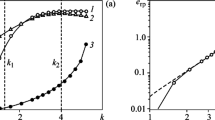Abstract
A model describing the crack propagation at the interface between a rigid substratum and a beam is considered. The interface is modeled using a fiber bundle model (i.e. using a discrete set of elements having a random strength). The distribution of avalanches, defined as the distance over which the crack is propagated under a fixed force, is studied in order to capture the effect of ageing and time-dependent response of the interface. The avalanches depend not only on the statistical distribution of strength but more importantly on time (or displacement) correlations. Namely, local fiber breakage kinetics is related to a correlation length, which sets the size of the fracture process zone which occurs ahead of the crack due to progressive failure. First, a variation of porosity of the interface is considered. It corresponds for instance to diffusion controlled dissolution processes. Interpreting the results in Delaplace et al. [Delaplace A, Roux S, Pijaudier-Cabot G (2001) J Eng Mech 127:646–652], it is shown that the size of the fracture process zone increases with increasing porosity in accordance with experimental observations [Haidar K, Pijaudier-Cabot G, Dubé J-F, Loukili A (2005) Mater Struct 38:201–210]. The creep–fracture interaction is analyzed in the second part of the paper. It is found based on a Maxwell model that the size of the process zone depends on the fracture propagating velocity and on the distribution of forces in the interface due to the interaction between the interface and the rest of the specimen. The observed decrease of the size of the process zone, in creep experiments, compared to the size of the process zone in a time-independent process, is justified by the proposed model for an interface that is less viscous than the rest of the material.
Similar content being viewed by others
References
Andersen J, Sornette D, Leung K-T (1997) Tricritical behavior in rupture induced by disorder. Phys Rev Lett 78(11):2140–2143
Batrouni GG, Hansen A, Schmittbuhl J (2002) Heterogeneous interfacial failure between two elastic blocks. Phys Rev E 65:036126
Bažant ZP, Gettu R (1992) Rate effects and load relaxation: static fracture of concrete. ACI Mater J 89(5):456–468
Bažant ZP, Jirasek M (2002) Nonlocal integral formulations for plasticity and damage: survey of progress. J Eng Mech 128:1119–1149
Bažant ZP, Li YN (1997) Cohesive crack with rate-dependent opening and viscoelasticity: I. Mathematical model and scaling. Int J Fract 86:247–265
Bažant ZP, Pijaudier-Cabot G (1988) Nonlocal continuum damage, localization instability and convergence. J Appl Mech ASME 55:287–294
Bažant ZP, Pijaudier-Cabot G (1989) Measurement of the characteristic length of nonlocal continuum. J Eng Mech 115:755–767
Bažant ZP, Planas J (1998) Fracture and size effect in concrete and other quasi-brittle materials. Boca Raton, London
Daniels H (1945) The statistical theory of the strength of bundles of threads. Proc Royal Soc A 183:405–435
Delaplace A (1999) Analyse Statistique de la Localisation dans les Matériaux Hétérogènes Quasi-Fragiles. Ph.D. Thesis, -Ecole Normale Supérieure de Cachan
Delaplace A, Roux S, Pijaudier-Cabot G (2001) Avalanche statistics of interface crack propagation in fiber bundle model: characterization of cohesive crack. J Eng Mech 127:646–652
Haidar K, Pijaudier-Cabot G, Dubé J-F, Loukili A (2005) Correlation between internal length, fracture process zone and size effect in mortar and model materials. Mater Struct 38:201–210
Harlow DG, Phoenix SL (1991) Approximations for the strength distribution and size effect in an idealized lattice model of material breakdown. J Phys Mech Solid 39:173–200
Hillerborg A, Modeer M, Pertersson PE (1976) Analysis of crack formation and crack growth in concrete by means of fracture mechanics and finite elements. CCR 6:773–782
Le Bellégo C, Dubé J-F, Pijaudier-Cabot G, Gérard B (2003a) Calibration of nonlocal damage model from size effect tests. Eur J Mech A Solid 22:33–46
Le Bellégo C, Pijaudier-Cabot G, Gérard B, Dubé J-F, Molez L (2003b) Coupled chemical and mechanical damage in calcium leached cementitious structures. J Eng Mech 129:333–341
Mazzotti C, Savoia M (2001) Experimental study of nonlinear creep of concrete at high stress levels. In: Bažant ZP, Ulm FJ, Whitmann FH (eds) Proc. concreep 6, Cambridge, England. Elsevier, Amsterdam, pp 259–264
Newman WI, Phoenix SL (2001) Time-dependent fiber bundles with local load sharing. Phys Rev E 63(2): 021507
Pijaudier-Cabot G, Benallal A (1993) Strain localization and bifurcation in a nonlocal continuum. Int J Solid Struct 30:1761–1775
G. Pijaudier-Cabot, Omar M, Loukili A, Le Pape Y (2005) Creep-damage interaction in concrete structures. In: Proceedings of ICF 11, Torino, March 2005
Zapperi S, Ray P, Stanley HE, Vespignani A (1997) First order transition in the breakdown of disordered media. Phys Rev Lett 78(8):1408–1411
Zhang S-D, Huang Z-Q, Ding E-J (1996) Complex fiber bundle model for optimization of heterogeneous. Phys Rev E 54:3314–3319
Author information
Authors and Affiliations
Corresponding author
Rights and permissions
About this article
Cite this article
Baxevanis, T., Dufour, F. & Pijaudier-Cabot, G. Interface crack propagation in porous and time-dependent materials analyzed with discrete models. Int J Fract 141, 561–571 (2006). https://doi.org/10.1007/s10704-006-9013-x
Received:
Accepted:
Published:
Issue Date:
DOI: https://doi.org/10.1007/s10704-006-9013-x




